The Meizu PRO 5 Review
by Matt Humrick on June 24, 2016 8:00 AM EST- Posted in
- Smartphones
- Exynos
- Mobile
- Meizu
- Exynos 7420
System Performance
The Meizu PRO 5’s internal hardware is very similar to the Samsung Galaxy S6’s—Exynos 7420 SoC, LPDDR4 1552MHz RAM, UFS 2.0 NAND—so it’s not unreasonable to expect a similar level of performance. When the PRO 5 and Galaxy S6 launched in 2015, the Exynos 7420 was the SoC to beat, offering better performance and efficiency thanks in part to being the first to use Samsung’s FinFET process. The Exynos 7420 has since been eclipsed by a new generation of SoCs, but it still delivers solid performance.
Smartphones are about more than just performance, of course. Battery life is paramount and is ultimately what makes a mobile device mobile. To help its users strike the right balance between these two opposing metrics, Meizu’s Flyme OS offers three different power modes: Saving, Balance, and Performance. The Saving mode shuts down the four higher-performing but higher-power Cortex-A57 CPU cores, effectively giving the PRO 5 a quad-core Cortex-A53 CPU running at up to 1.5GHz, and is meant to prolong battery life at the expense of performance. The Balance mode, like its name suggests, tries to strike an equal balance between battery life and performance by disabling two A57 cores and capping the max frequency of the remaining two at 1.8GHz. The four A53 cores are still available at their max frequency of 1.5GHz. The Performance mode allows all eight CPU cores to run at their max rated frequencies simultaneously if needed.
To measure the impact of this strategy, we tested the PRO 5 in both its Performance and Balance modes. Results for both are shown in the charts on the next few pages.
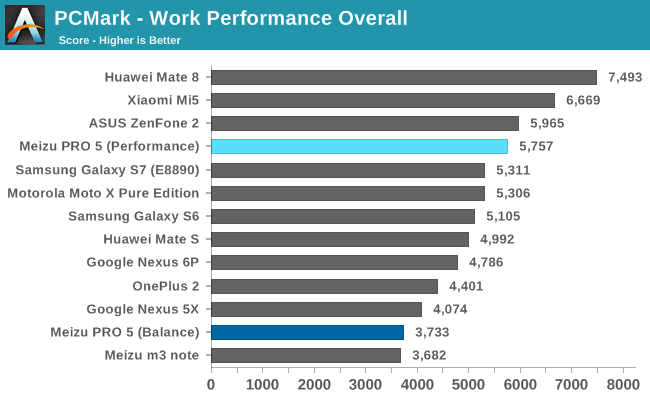
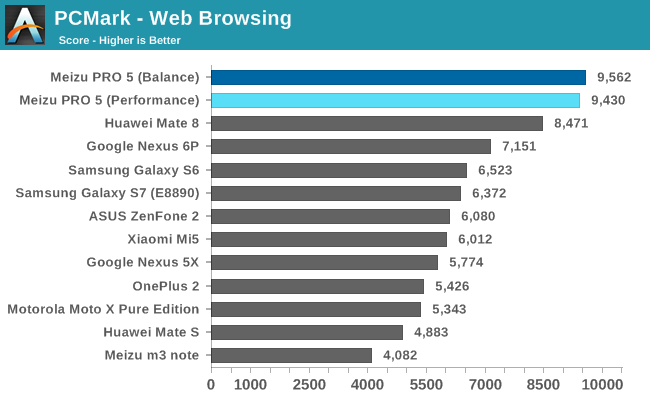
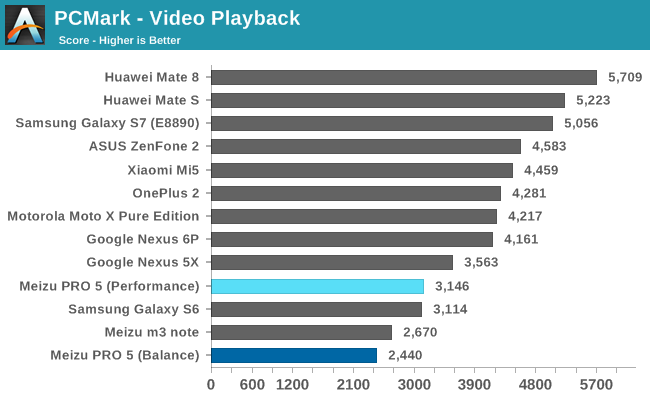
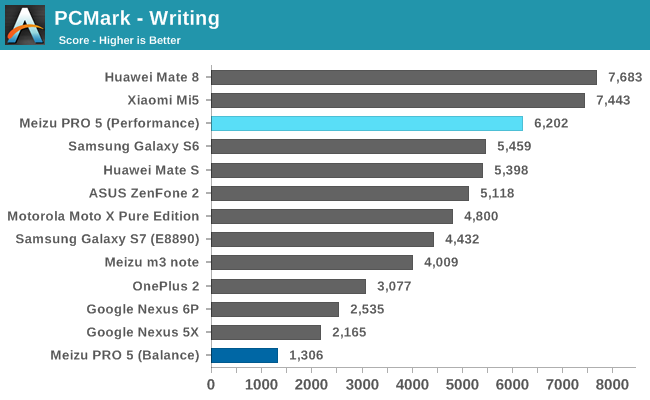
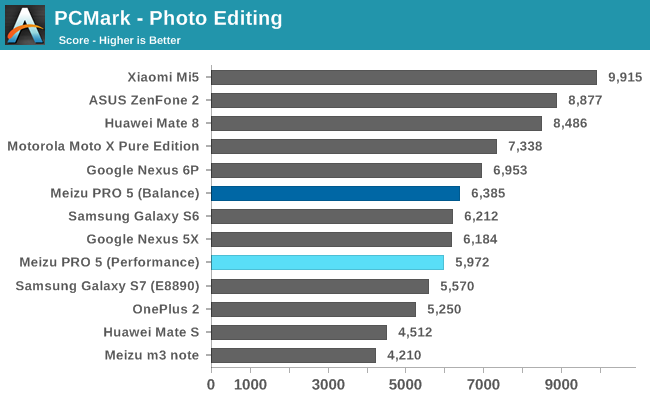
PCMark’s real-world workloads evaluate overall system performance by exercising the CPU, RAM, and NAND storage. Instead of pegging the CPU cores at their max frequency like synthetic benchmarks, PCMark elicits more realistic behavior from the CPU governor, making it a good indicator of how other apps that we use every day will perform.
Looking first at the overall score, the PRO 5 does well, outperforming even newer flagships like the Galaxy S7. We also see a significant difference between the PRO 5’s Performance and Balance modes, with the former providing a 54% boost. However, overall scores can often be misleading.
Diving into the individual tests, the PRO 5 seems to deliver exceptional performance in Web Browsing with no discernable difference between the two power modes. Video Playback is similar to the Galaxy S6 in Performance mode, which holds a 29% advantage over Balance mode, although neither device using the Exynos 7420 does particularly well in this test. The PRO 5, like the S6, performs well in the Writing test, well, at least sometimes.
The PRO 5 produces erratic results in both the Video Playback and Writing tests when using the Performance mode. Around half the time it delivers results similar to those in the charts above. The other times, however, the PRO 5 shuts down the A57 cores completely and idles the A53 cores at 400MHz for the duration of these two tests, resulting in horrible scores. This appears to be a bug with Meizu’s DVFS implementation. The good news is that I was not able to reproduce this scenario while running several different apps from Meizu, Google, and third-parties, so this appears to be limited to PCMark. Without more comprehensive testing there’s no guarantee that some app or workload will not trigger this behavior, however. Using Balance mode could be a workaround, because it did not suffer from this issue.

We recently added DiscoMark to our test suite as part of our effort to better capture real-world performance. You can find a good explanation of how this test works and how we are using it in our LG G5 review, but basically this test measures application launch times by using Android's accessibility services to monitor an application’s startActivity() method, which starts the process of building the app’s UI elements.
The PRO 5 opens apps from internal storage very quickly, noticeably faster than the Nexus 5X and Nexus 6P, and essentially equal to even the latest flagship phones. Switching to Balance mode slows performance by 31%, but it still feels very fast.
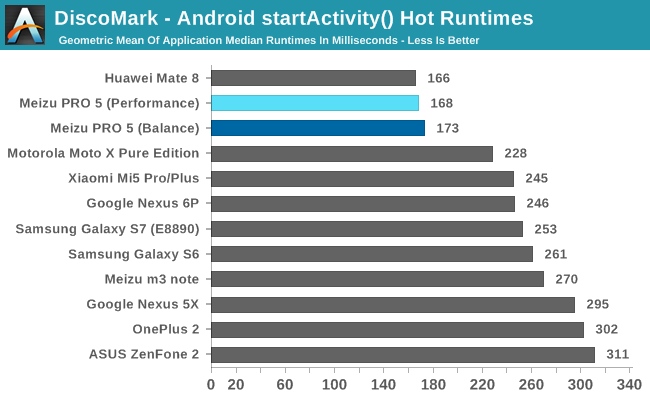
The PRO 5 is also very fast when switching between apps that are already loaded in RAM, with no penalty when using Balance mode. It equals the performance of Huawei’s Mate 8 and P9 and holds a 25% to 35% advantage over the other phones in the chart going back to the Galaxy S6.
Taken together, PCMark and DiscoMark show the PRO 5 performs very well with common, everyday tasks, which agrees with my personal experience while using the phone. The UI is fluid, the keyboard responds as quickly as I can move my thumbs, and scrolling through image-heavy web pages is smooth.

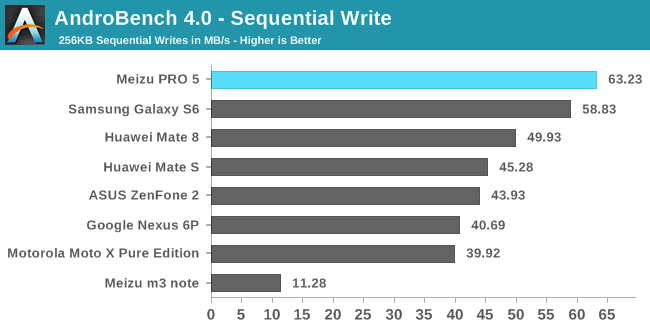
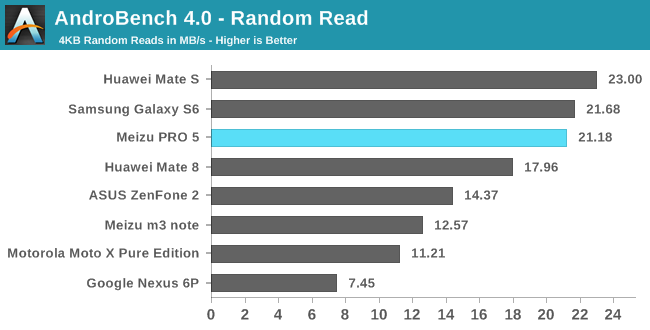
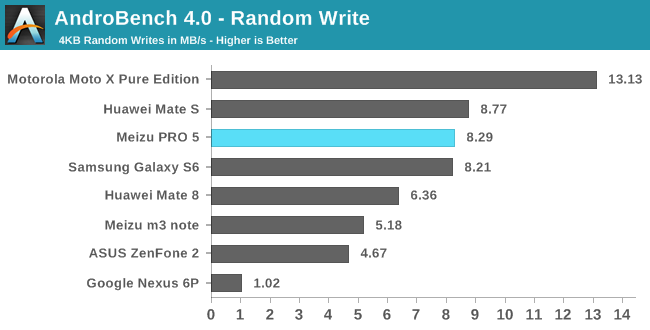
In our internal storage test, the PRO 5 posts very good results across the board, part of the reason why it does so well with launching applications. It’s not surprising that we see the PRO 5 and Galaxy S6 post near identical speeds, because both are using the same UFS 2.0 controller that’s built into the Exynos 7420 SoC and the same KLUBG4G1BD-E0B1 NAND with a maximum queue depth of 16.
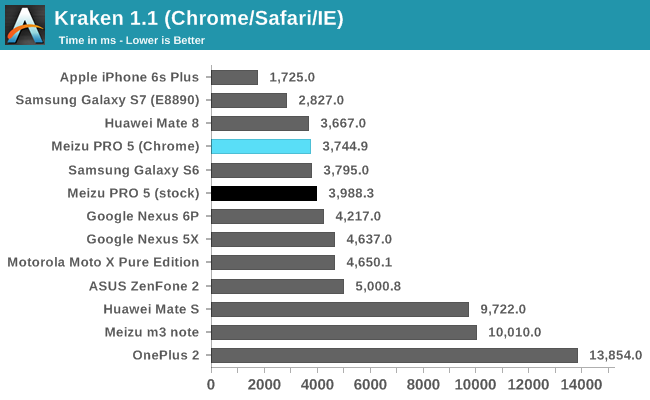
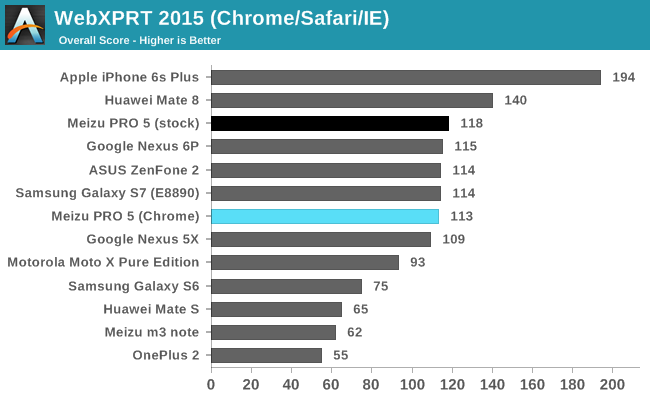

Chrome is the default browser in our web-based JavaScript tests, but we’re also including the results from Meizu’s stock browser for comparison. Unfortunately, it does not provide any better performance than Chrome.
The PRO 5 performs as good or better than the phones with previous generation SoCs. It lands near the top of the chart in Kraken and is around 20% slower than the Mate 8 and its Kirin 950 SoC in JetStream and WebXPRT.
Despite launching at the end of 2015, the PRO 5 still feels plenty fast and compares well to current generation flagship phones. While there is a performance penalty when using the Balance mode to conserve power, it’s generally not severe and not even noticeable in most cases.


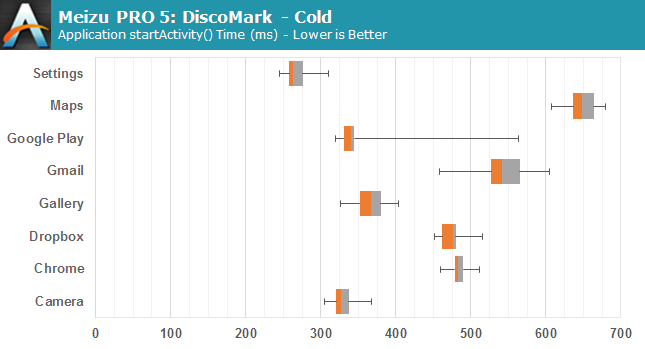









80 Comments
View All Comments
Impulses - Friday, June 24, 2016 - link
Yup, personally I don't care much for these reviews (unless the devices are more readily available in the USA) but I don't mind them either (the audio part here was very interesting!) AND I DO remember reading requests for Meizu/Xiaomi/etc reviews for a long long time in the comments section of older reviews... I've no doubt Andrei is right as far as the existing demand for this content.jimbo2779 - Friday, June 24, 2016 - link
I think it's great to see brands that are not just us centric.aryonoco - Friday, June 24, 2016 - link
Thanks Andrei.I have no problems with phones targeting different markets being reviewed. In fact as someone from Australia, I like that AT seems to be less NA focused recently.
Can I just ask that reviews list the LTE bands supported clearly in the spec table? It really is as important as storage or camera spec, at least. I know which bands my carrier uses, so if the LTE bands are listed, I'd know if the phone is useful for me or not. Sometimes finding exactly the LTE bands that some of these Chinese phones support is not at all east.
asfletch - Monday, June 27, 2016 - link
At least most Chinese phones support band 3, which is common to all the major carriers here in Australia. Makes them much more attractive for us than for US buyers. Many also support Band 40, which is used by Optus. Support for Bands 5 and 28 is rare though, so we tend not to get the fastest available service on Chinese handsets.LiverpoolFC5903 - Tuesday, July 5, 2016 - link
Thank you!The likes of Meizu, Xiaomi,Oppo, Vivo, Huawei, ZTE, One plus and others have a lot of good stuff to offer and at mostly great prices.
Keep doing what you are doing, love the content on here.
andychow - Sunday, June 26, 2016 - link
I agree with you %100. Anandtech doesn't review %20 of available phones, why would they review phones incompatible with North American LTE? Cover us first, then cover the in-compatible phones with a big warning. America comes first. That's the truth.more-or-less - Friday, June 24, 2016 - link
BTW to all AT editors, can you include comments using Facebook/Twitter/Google/Disqus etc., I have been reading for years, yet never wanted to create a seperate account for commenting.Impulses - Friday, June 24, 2016 - link
Disqus is annoying AF... IMO Only good part about it are email notifications, but it loads slow and doesn't look that great.Eden-K121D - Friday, June 24, 2016 - link
AnandTech is too goddamn lazy and lethargic to bring the S7 review part 2 or HTC 10 review or GTX 1080/70 reviwGeranium - Friday, June 24, 2016 - link
@AnandTech,Why you guys are putting Android benchmark and iOS benchmark in same chart? Aren't those different platform?